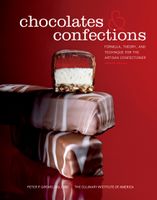Advertisement
Theory: Inversion
By Peter Greweling and Culinary Institute of America
Published 2007
Inversion is the name given to the hydrolysis of sucrose into fructose and dextrose. To put it simply, when it is exposed to acid, heat, and water, sucrose, a disaccharide, breaks into the two monosaccharides that make it up. This reaction is ongoing as long as the sugar and acid are in a fluid state; the longer the acid is exposed to the sugar, the more the sugar is inverted. This reaction may also occur from exposure to the enzyme invertase, as when making cordials. The word inversion refers to the direction that polarized light rotates passing through the sugars, and may be a descriptive term for chemists, but is virtually meaningless to confectioners. The important points to remember about inversion are the qualities of invert sugar (the resulting mixture of fructose and dextrose) as compared with sucrose. Invert sugar is:



